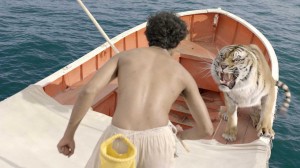
Sound design on director Ang Lee’s Life Of Pi required a tremendous amount of ocean sounds for a major part of the movie that takes place aboard small life boat adrift in the Pacific ocean. The epic journey begins after a disaster at sea that strands a young man, Pi Patel, alone except for an unlikely companion, a fully-grown Bengal tiger. Fortunately, the sound designer on the picture, Eugene Gearty, lives near the sea in South Carolina where he had been capturing waves and thunder (key elements for the picture) and a whole plethora of sounds for years. And since all of the scenes in the lifeboat where shot in a tank built in an airplane hanger at an abandoned airport in Taiwan, none of the production sound could be used and the entire soundscape had to be created in post.
The most difficult task for Gearty wasn’t the storm or the sea. He explained, “I would say, far and away, creating a character out of Richard Parker with vocalizations, was the most difficult, because the tiger wasn’t real and almost all CGI.” In the story, a mix-up with the adoption papers at the zoo left the tiger with the name of his former owner, Richard Parker. Gearty went on, “You would think you were looking at a real tiger the whole time, but every time you saw Pi and the tiger together, it was fake! It was 99.9% CG of the tiger and 100% of the other animals.”

It took quite some time to collect all the sounds necessary for the film. Gearty continued, “We started in January when we got the prop of the life boat used in the shoot. We recorded that off San Pedro near Catalina Island. Then I recorded all of the animals that same month. I started designing and cutting everything after that. It was a very long job, but it was a dream job!”
As GCI gets better and better, we often take for granted that a major part of storytelling, and indeed making the shot believable, lies with the sound designer making it all come to life. Gearty offered, “Sound design is based in storytelling in a movie like this. Everything tells the story. Everything!” Sound design always has been important, but as audiences get smarter, it becomes even more so. “There’s no sense in having a weird sound in there if it doesn’t relate somehow emotionally to what’s happening in the scene or the storyline. The days of weird sounds for their own weirdness are long gone,” Gearty added. Convincing audiences that what they are seeing is real, is what it is all about. The more involved and realistic CGI gets, the more it needs good sound design. It’s good to see excellent sound designers step up to the plate and take us to places we have not gone before, and see things we have not seen before. And most important, believe it all.





